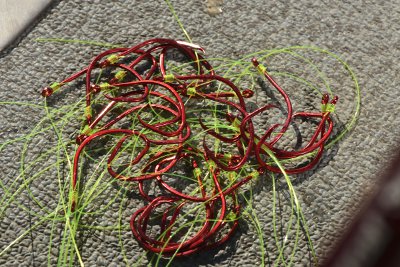
Days afloat America’s preeminent channel catfish stream, Captain Brad Durick sees a little of everything. One client, a self-proclaimed ‘fishing expert,’ reels with the rod upside-down. Another customer continuously misses bites, jerking back against a self-setting circle hook rig, despite continued pleas to the contrary. A bass oriented dude gets his thumb chomped while attempting to lip-lock a 20-pound channel (big catfish bite back, à la snapping turtle).
Durick fields his share of questions, too.
“Can catfish sting with their whiskers?” (No.)
“Are catfish poisonous?” (Negative.)
“I heard they eat puppies and unsuspecting swimmers. Is that true?” (Possibly, if they weighed 200 pounds.)
To the Red River, North Dakota-based guide’s credit, Durick simply chuckles and patiently answers each question in turn, even if it’s the 957th time he’s heard it. Teaching moments, Durick calls them. When you boat over 1,500 big channel cats, as he does each season, you’re presented with plenty of opportunities to learn.
His most valuable message?
“Catch and release works,” Durick says. “But only if you learn to properly handle your fish. We post a lot of photos on social media, so it’s not just my clients who pay attention to how we treat our fish, but often thousands of other online observers.”
Scoop, Grip and Grin
“First thing I tell my clients is to get a good net; one with micro-mesh that won’t harm a catfish’s delicate skin. Unlike most species, cats aren’t armed with skin-protecting scales. Instead, they secrete a viscous substance that acts as an antiseptic. So you want knotless netting that won’t abrade skin or remove their vital slime layer. And you also want a net with a flat bottom panel, that will gently support the fish without contorting its body in abnormal angles.”
Faced with an absence of catfish-specific landing nets, Durick came across Frabill’s 5521 Pro-Formance Halibut Net. “Not only is the micro-mesh easy on catfish skin, it’s the only net that won’t allow sinkers to drop through openings and become tangled. That’s a nightmare with other nets. More and more cat guys are using this net. It’s got a collapsible slide handle, too, and Frabill’s super tough Pow’R-Lok yoke withstands the torque of giant fish.”
When faced with double-headers—a common occurrence on the Red—Durick offers another tip: “A lot of anglers will land one fish, and then dump it on the boat floor until they net the second fish. A wild catfish on the boat floor is asking for trouble—broken equipment, sprained ankles or injured fish. It’s why I like to double net. Dip the first catfish, and leave it in the net in the water until you finally net the second fish. The big Frabill easily accommodates both cats at once, and keeps them nice and healthy.”
Typically, the net’s also the right place to remove hooks, again, keeping catfish in water for as long as possible. “When you’re ready to snap a photo, we’ll often use a Rippin Lips Big Fish Gripper. Lock onto the catfish’s lower jaw and lift, while supporting the rest of its body by reaching around its tail.”
The Big Fish Gripper, Durick notes, is perfect for folks unaccustomed to dealing with big fish, or nervous about the sharp pectoral and dorsal spines on those fins. “Smaller cats have especially prickly spines,” he says, “making a fish gripper a valuable tool for protecting both fish and angler.”
Slimy Solutions
Durick adds interesting advice for remedying cuts on hands and fingers, should you receive a spine to the thumb, or other minor scratch. “It’s an old catman trick, but it works—rub a little catfish slime on a fresh cut. Folks are amazed by how quickly this natural “medicine” stops the sting.
“Catfish slime seems to be a powerful, almost magical healing agent. You should see some of the nasty wounds on spawning catfish each year. Often, we’ll re-catch the same fish several weeks later and all the wounds have completely healed over.”
Interestingly, Durick and other anglers use another natural curative agent not exactly designed as such. “No Trace is a benign scent eliminating spray we use to mask fish-repelling unnatural odors (bug spray, gas, human pheromones, etc.) from our hands. Turns out, the stuff is also a natural antiseptic, preventing infections on minor wounds. No one would mistake me for a doctor, but both these remedies work for catfish anglers—and have worked—for many years.”
From human health back to the well-being of catfish, Durick notes another catfish-handling no-no. “Vertical holds are out. You want to fully support the weight of the fish with both hands. We often keep hands away from gills and gill openings, too. If you look at the photos we post, you see that we grip the narrow body section just below the tail with one hand and then basically cradle the fish’s head and shoulders with the other, avoiding pectoral and dorsal fins completely. If the fish decides to shake, you simply keep a firm grip on the tail and keep its head balanced until it calms down. It’s an safe, easy grip that just works.”

Full Circle Conservation
As to the process of actually catching catfish, Durick discusses his choice in hooks, and why they’re a huge part of his catch and release program. “Just yesterday, we gut hooked our first catfish of the season,” he says. “Using our Tournament Grade Circle Hooks, that puts us at just under .1-percent for the year.”
On the positive side of the equation, Durick has successfully hooked over 99-percent of his catfish neatly in the corner of the lip, thanks to his specialized wide gap circle hooks. “By now, most folks know that circle hooks work brilliantly without setting the hook. But they’re also awesome for avoiding deep-hooking fish when presenting livebait or natural cutbait. Truth is, too, once you hook a fish with a Tournament Grade Circle, you rarely loose it. When I’m just out fishing for fun, I’ll often mash down the barbs on my hooks, and still almost never will a catfish shake free.
“Circle hooks are a guide’s dream for hooking catfish safely and securely. But you really need to examine how each model is made before choosing the right one for your fishing. The Tournament Grade hook I use is designed just for catfish—has the optimal offset angle and gap to pivot and penetrate a cat’s thick, bony jaw, nearly always in the corner of the mouth. Makes my job exponentially easier—and safer for everyone.”
Back afloat the Red River of the North, where all catfish over 24-inches must be released (on the U.S. side of the river), Durick continues to see the positive proof of catch-and-release catfishing. “Small cats make for wonderful meals. But the bigger fish go back. It’s what makes this river so special—really the most unique channel catfish stream on earth.”
Just initiated this past year, a comprehensive catfish tracking study has put tags into 14,000 Red River channels. Beyond monitoring the astounding long-distance movements of these catfish, the study is proving the efficacy of catch and release. One particular fish, tagged in Selkirk, Manitoba last June was caught by Durick in Drayton, North Dakota this May; the same fish was caught, reported and released again from the Grand Forks stretch in June—a nearly 500 mile upstream journey. Several other tagged fish caught by Durick have been re-captured by other anglers up to three additional times.
It all helps explain and prove why trophy catfishing is as “red” hot here as it’s been for nearly four decades.
